Excerpt from ‘The history of the Black Shroud, from Amdapor to Gridania’ by Archon Niniri Niri.
The histories of Eorzea tell us that Gelmorra was born out of the terror of magic produced by the Sixth Umbral Calamity. In the wake of the colossal floods that characterized the Calamity the survivors turned on the arts of magic that had caused the disaster, putting both knowledge and practitioners to the flame. The elementals of the Twelveswood were enraged by the excess of Amdapor and its contemporaries, and the Hyur and Elezen of the Black Shroud, unable to commune with the elementals after abandoning magic, were driven underground, where they would later join hands and found the underground city of Gelmorra. Over the course of centuries the people of Gelmorra re-discovered the arts of conjury and were able to re-establish ties with the elementals, migrating above-ground once more and founding the state of Gridania.
One of the countless Gelmorran ruins still accessible from the surface, the Tam-Tara Deepcroft saw use by Gridania even after the fall of Gelmorra. It was used as a crypt for the city-state’s dead, as it was once the resting place of Gelmorra’s kings and nobles, but in the wake of the fall of Dalamud it was seized by the dangerous cult known as the Lambs of Dalamud. Testimony by the people of Eorzea speaks to the rise of this cult as followers of the lesser moon itself as it descended to the surface. In order to hasten the impending destruction these demented individuals participated in blood sacrifice to hasten the moon’s fall, and when Dalamud was destroyed at Carteneau Flats they chose to believe that it was the fault of disbelievers. The cult scattered, settling in a number of aetherically rich locations to carry out their vengeance.
Eyewitness testimony suggests that it was commonplace for the Lambs to summon voidsent, a fact that is further established by the accounts of the adventurers that purged the Deepcroft. Apparently the goal of the Lambs in the Deepcroft was to use the dead of Gridania and Gelmorra as vessels to summon voidsent, particularly a voidsent of the sixth rung of the voidal hierarchy. The God’s Quiver, archers, scouts and mobile guards of Gridania, found themselves unable to lend the Deepcroft the required resources and instead turned to adventurers, who purged Tam-Tara themselves.
The Deepcroft Proper
The central room of the Deepcroft is a colossal vaulted chamber. The walls are populated by antechambers not current accessible by the main room, and which likely contain the remains of Gelmorra’s aristocracy and royalty. Indeed, reports on the Deepcroft discuss the emblazonment of the subterranean city’s crest. This crest is strikingly similar to the crest of Gridania, retaining the twined adders but replacing the central lily with what appears to be a bushel of fungi or other subterranean flora. This makes sense, as the surviving annals of Gelmorra tell us that the twin adders represent the bond between hyur and elezen, while the lily is a more recent invention that symbolizes Gridania’s pact with the elementals. The fungi likely instead represent Gelmorra’s flourishing in the harsh circumstances the city found itself in.
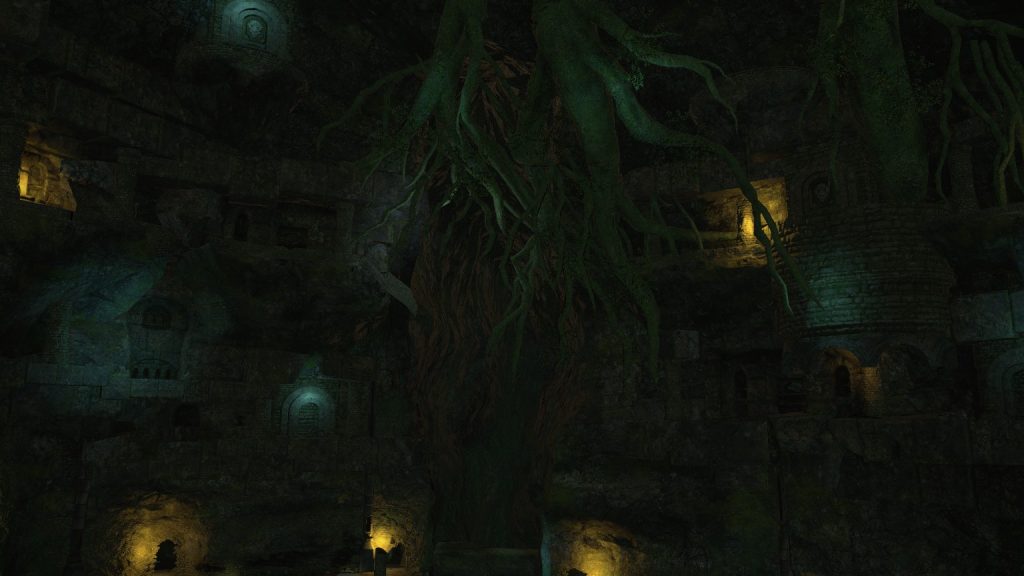
The platform at the entrance ends in a drop towards the depths of the Deepcroft, and provides an excellent view of the downwards spiral that comprises the majority of Tam-Tara. This can be best seen from a large outcropping that, judging by the crumbling handrails, was once an observation platform that one could overlook the funerary grounds from. One can pass further into the complex through a stone corridor, lined with alcoves occupied by stone sarcophagi, likely inhabited by the dead of Gelmorra and Gridania.
An offshoot leads to a circular room that is home to a small pool of clear water beneath a stone structure that seems to frame the pool and provide a sense of ornate-ness. The water here may be filtered naturally through the rock or produced by an abundance of water-aspected aether in the area, and researchers noted the presence of a number of bioluminescent insects, perhaps breeding in the water. Regardless, this pool was likely used to some kind of sacred bathing of cleansing relevant to the funerary rites of Gelmorra.
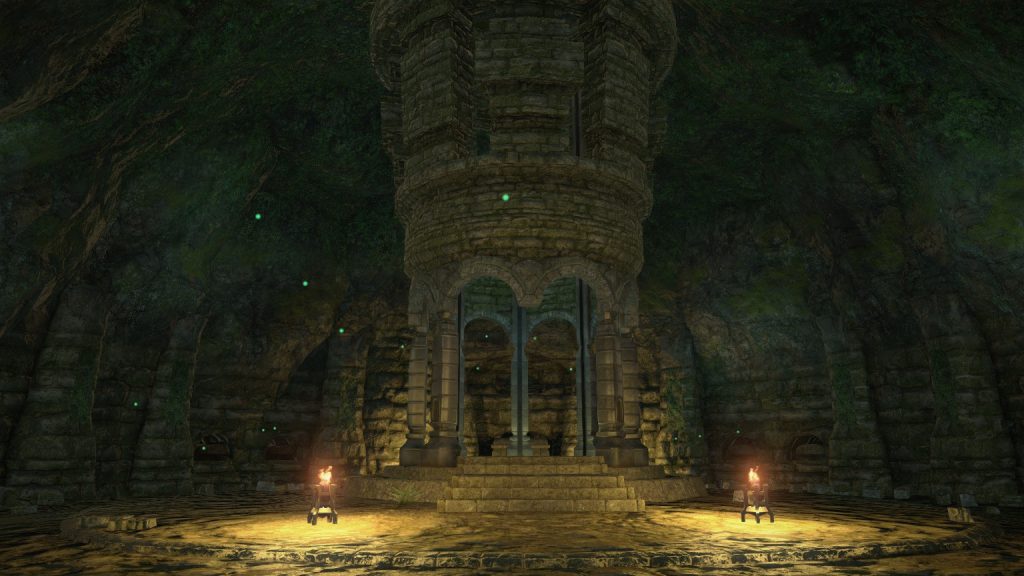
A particularly notable sarcophagus can be found at the back of the room, given pride of place outside of an alcove as well as being much larger than the lesser sarcophagi. Judging by the fact that this stands outside of the crypt of a particular noble family this author must conclude that it belongs to a former monarch of Gelmorra or a priest, judging by the sarcophagus’ placement nearby the pool.

The Ak-Inik Tomb
Archaeological evidence and the records of Gridania suggest that the first distinct burial chamber of the Deepcroft belonged to the venerable Inik noble family. This family was noted as a noble house. The ak- segment of their name denotes that the context is one revolving around the honored dead of the house. Four lesser sarcophagi can be found here alongside a larger one, alongside two especially small ones. These are most likely the graves of the scions produced by the House of Inik.
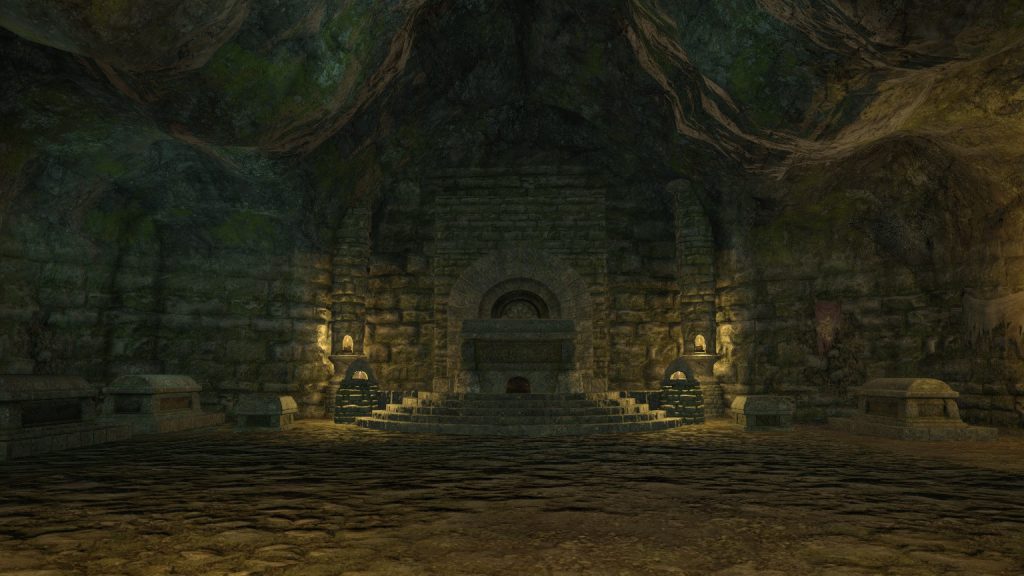
A small purple banner with an ornate golden symbol emblazoned across it can be found in this room, and despite consulting with various fellow historians the author has not been able to track down the exact meaning of this symbol. It could well be an insignia of the Inik family, but it is found elsewhere throughout the Deepcroft and thus may be a more general symbol of Gelmorran religiosity or the monarchy and aristocracy.
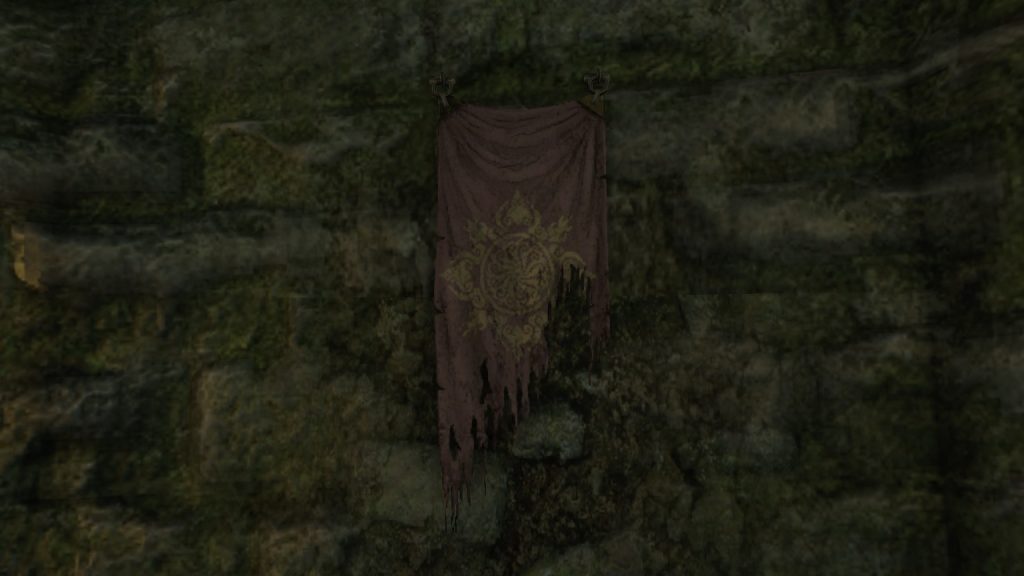
The Altars of the Deepcroft
The Deepcroft contains a triad of altars festooned with now-cold incense-burners and candelabra. These were the sites where the Lambs of Dalamud were channeling energies for their summoning ritual, and although they are no longer present the testimony of adventurers speaks of an ornate orb used to channel the energy used to bring forth the voidsent. The ancient names of these altar are fascinating, and are as follows; the Greenwood, Hardwood and Wormwood altars. Greenwood is a term used to refer to a forest that is in full bloom, while hardwood can be used to refer to wood from broadleaved trees, though I suspect that it may instead reference the term for clippings of mature plants taken in winter. Wormwood is both a kind of shrub known for its bitter taste used in alcohol, as well as a term for bitterness and grief.
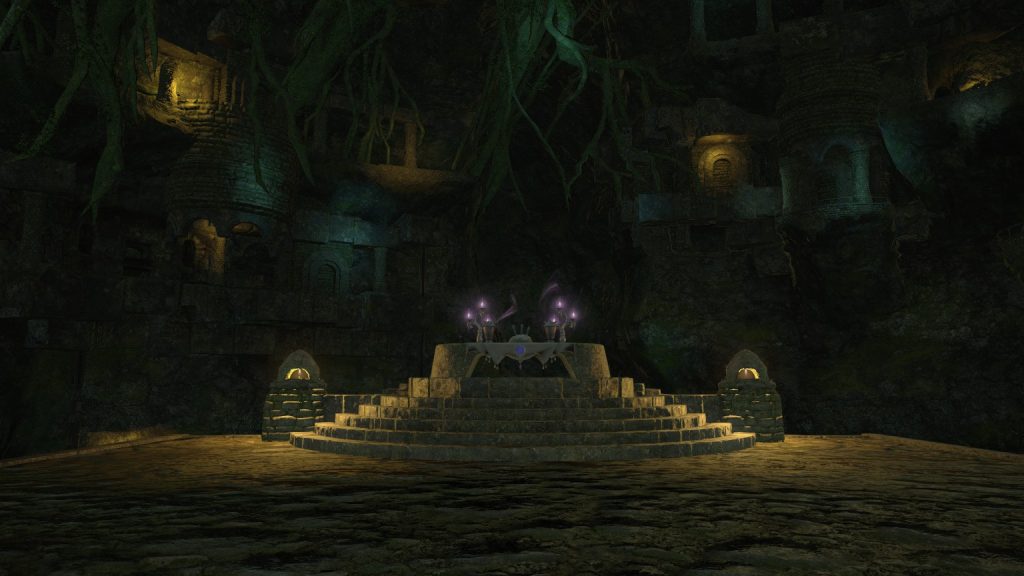
This is evidently a metaphor for the Gelmorran perception of life and death, as would befit a crypt. A corpse starts their journey, blessed at the Greenwood Altar in order to signify the prime of their life before proceeding to the Hardwood Altar, a metaphor for the winter of their life, then finally the Wormwood in order to signify the bitterness and grief left behind after their death.
The Tomb of King Galvanth the Dominator
A small chamber that branches off from the main corridors, this was the resting place of Galvanth the Dominator, an honored and respected king of Gelmorra. There is a central sarcophagus which accommodates the Dominator’s corpse once more after the destruction of the Lambs of Dalamud. There are four additional sarcophagi in the room, which are likely host to relatives or retainers of the king. A decorative metal fence partially separates the King’s coffins from the others and is decorated with what appear to be simple metal targes, a form of shield commonly employed by those who cast magics. This may then be a reference to some sacred warding of the King’s resting place.
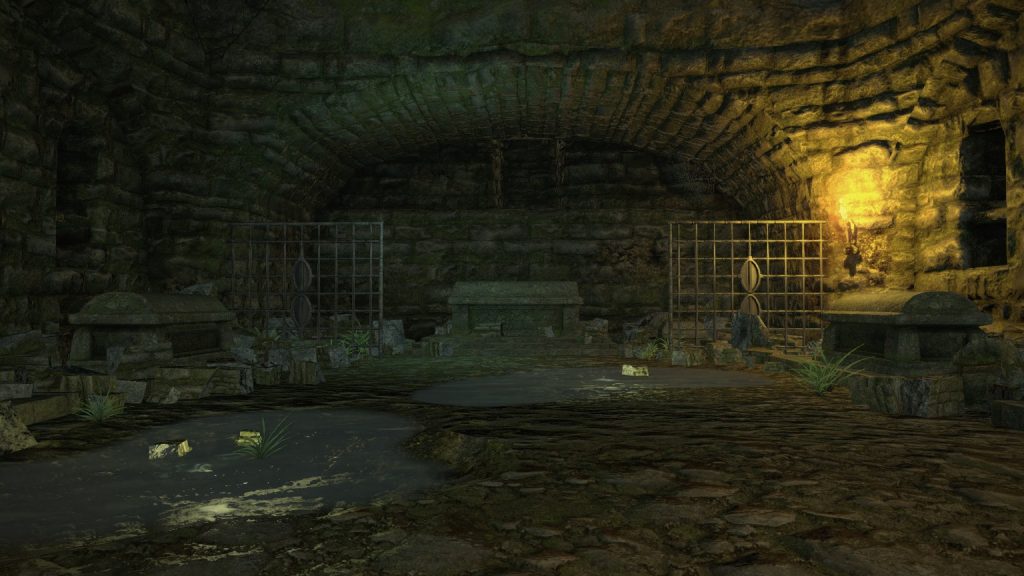
The King was once more interred here by the padjal E-Una-Kotor after the purge of the Deepcroft, alongside a ritual of cleansing and purification. E-Una-Kotor, according to my research, appears to be a padjal with particular interest in the history of Gelmorra, judging by the fact that it is he that currently presides over the excavations of the odd Gelmorran labyrinth found beneath the South Shroud.
The Interring Chamber
As one passes further through the Deepcroft they find themselves in a modest chamber filled with an array of sealed clay pots. This is the interring chamber, and the knowledge of Gridania tells us that it was here that the bodies were prepared and placed within their sarcophagi. The pots within the room likely contain supplies for embalming as well as the viscera of those laid to rest within the Deepcroft, as a method of preservation.
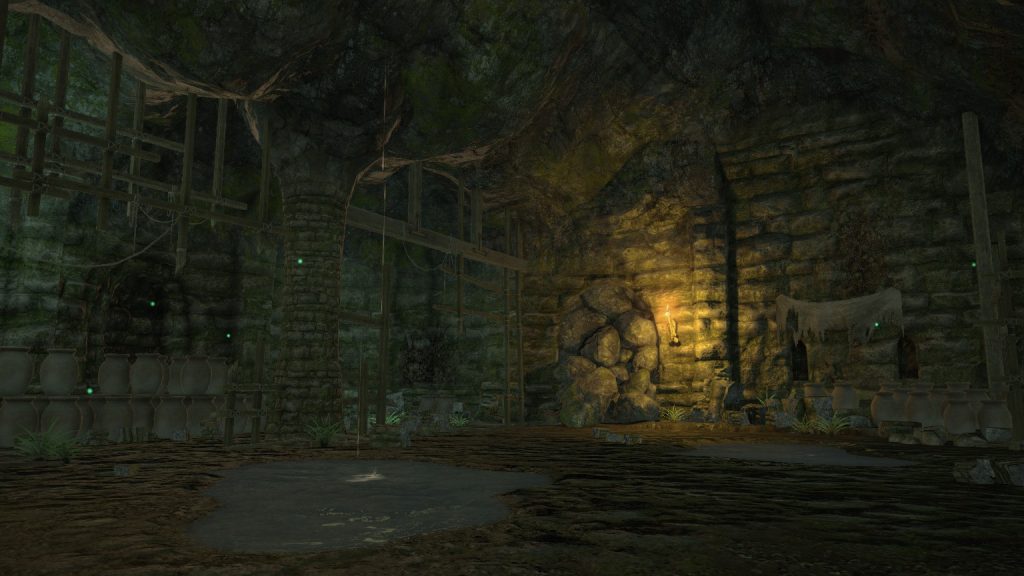
Further beyond the interring chamber is another room, albeit one whose name has been lost to time. It somewhat resembled the room with the pool from the higher reaches of the Deepcroft in that it contains what seems to be a fountain of some kind. Although it no longer flows, water still occupies the basin. A number of sarcophagi can be found in alcoves within this room. This water-feature likely played a role in sacred cleansing rituals of some kind, perhaps for the bodies of those who have passed away.
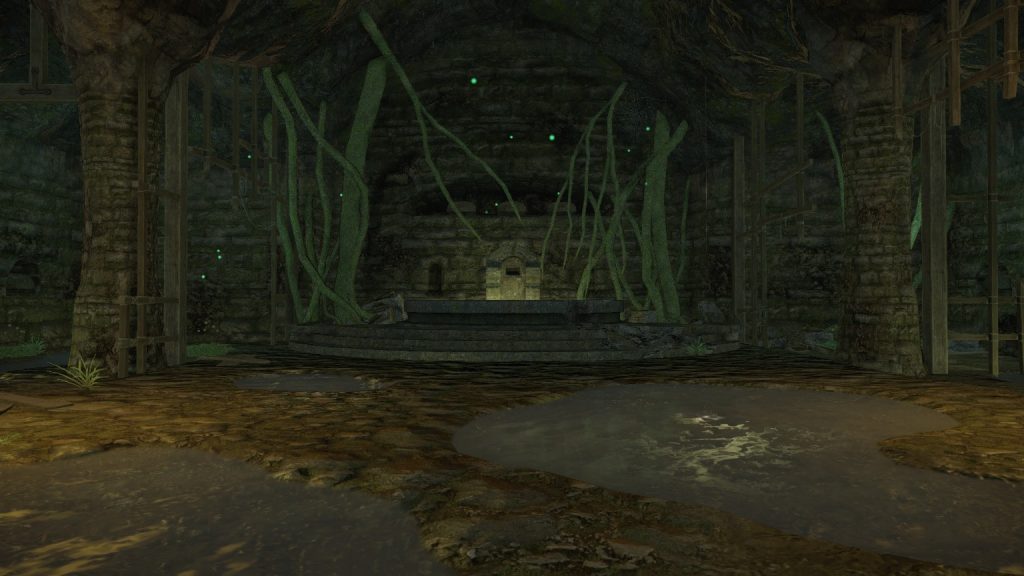
The Ak-Mena Tomb
The second of the two noble house crypts within the Deepcroft, this is the resting place of the Mena family. The side of the chamber has unfortunately collapsed into a ravine judging by archaeological reports from the site, constituting a great loss of valuable Gelmorran history. There are no sarcophagi in the room, and they have likely fallen into the crevasse with the rest of the room. An altar can be found before the sigil of Gelmorra at the end of the room, likely used in honor of the dead and Gelmorra’s patron goddess, Nophica. According to the forces that purged the Deepcroft after the cult took over the tomb this altar was used to store a gemstone that acted as a key to the defensive wards of the Lambs, and pulsed with a malevolent energy, likely suggesting an umbral polarity for the aether within this ‘rosary’.
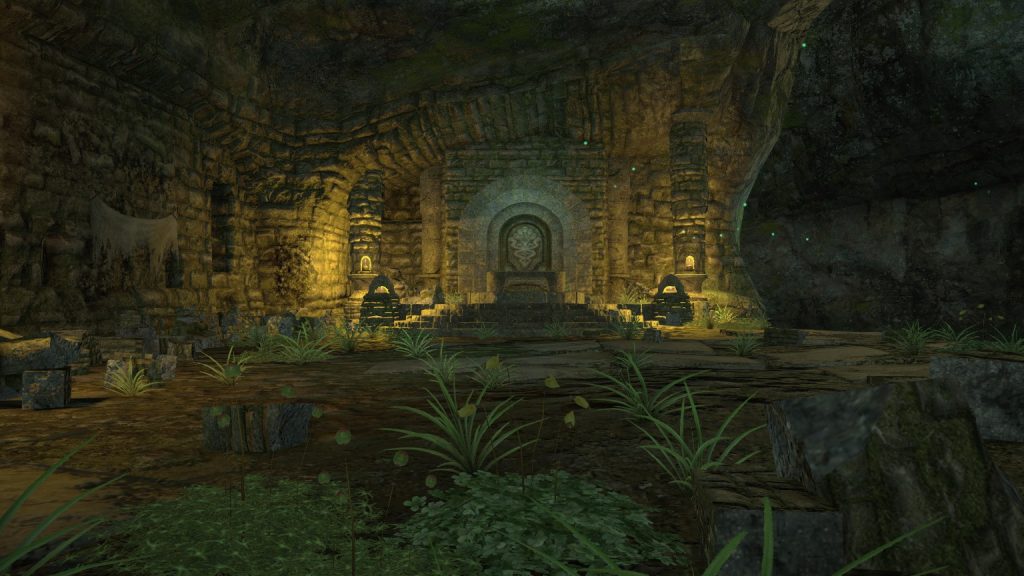
The Eternal Calm
The central platform of the Deepcroft, the Eternal Calm is a wide pillar with a series of braziers and linked Gelmorran crests at the top. The name of this platform doubtless holds significance with respects to death, and is likely a term for death itself. Clearly then, the platform held a critical role in the funeary rights practiced within the Deepcroft. This may have taken the form of a platform on which ceremonies were carried out, or as a place in which particularly revered figures lay in state.
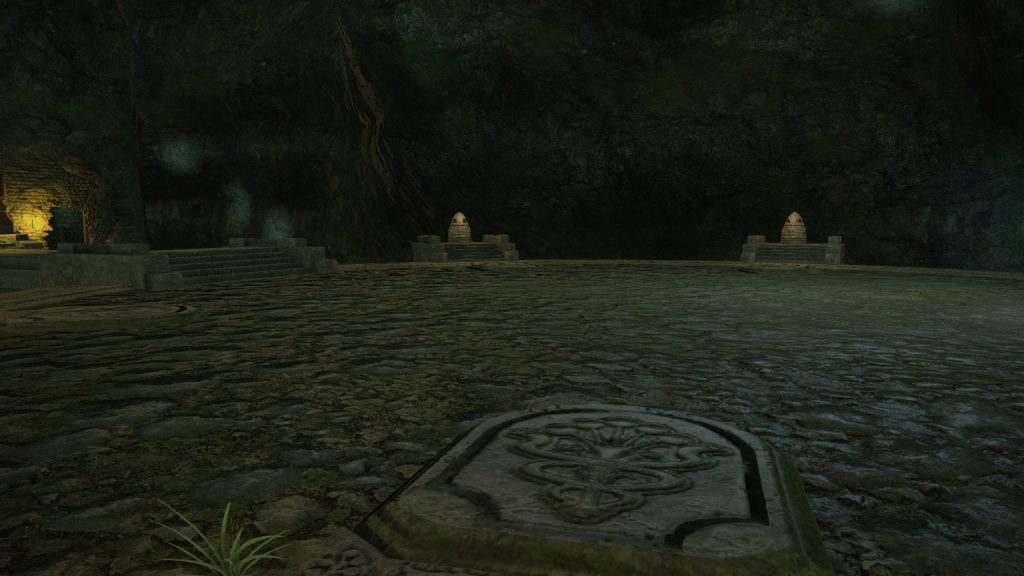




Leave a Reply